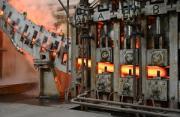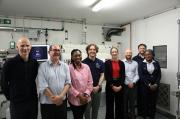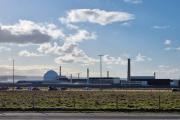UKAEA Fined £15,000 - MARSHALL LAB - IMPROVEMENTS TO PROCEDURES MADE
12th July 2007
Improvements have been made to the UKAEA's procedures for temporary waste storage following shortcomings identified by the Nuclear Installations Inspectorate.
Speaking outside Wick Sheriff Court, where UKAEA was fined £15,000 after pleading guilty to the charge, Simon Middlemas, Dounreay's site director said "We accept some mistakes were made in the Marshall Lab at the beginning of last year resulting in a worker receiving a very minimal plutonium intake. It should not have happened and we, very quickly, addressed a number of issues highlighted by the NII."
UKAEA's director of safety, Dr John Crofts said "Our procedures have been tightened and a number of behavioural safety initiatives have been set in place to ensure this that type of incident should never occur again."
The Fuel Cycle Laboratory (known as the Marshall Lab) was built in 1981 and carried out development and proving trials for the Thermal Oxide Reprocessing Plant (THORP) at Sellafield, for the Japanese MOX (mixed-oxide fuel) reprocessing programme and for the EDRP (European Demonstration Reprocessing Plant) design. Work is now underway to decommission the plant.
The charge relates to an incident which occurred in January 2006 where two employees were found to have an elevated personal air sampler reading after undertaking some wok in the decontamination room located near the alpha lab. The work being carried out related to the storage of lead bricks and their subsequent disposal as intermediate level waste.
Related Businesses
Related Articles
UKAEA develops 3D printing for fusion components
At its recently opened Central Support Facility (CSF), UKAEA has commissioned an electron beam additive manufacturing machine that can be used to incorporate tungsten into components, alongside a selective laser manufacturing machine. Fusion can play a key role in a global low carbon energy future.Advancing Fusion Remote Maintenance: Industry Collaboration Driving Innovation
As part of the‚ÄĮFusion Futures (FF) programme, UKAEA's‚ÄĮ Remote Applications in Challenging Environments (RACE) ‚ÄĮhas partnered with industry leaders to develop two groundbreaking technologies for remote maintenance in fusion energy engineering. Thanks to FF funding, industry has taken the lead in maturing UKAEA technology concepts‚ÄĒdelivering real-world solutions that enhance operational autonomy and reduce maintenance burdens in extreme environments.UKAEA launches International Fellowships Scheme for fusion
UKAEA has launched the International Fellowships Scheme, an initiative to help expand the global talent pool supporting the fusion industry. The scheme is part of the UKAEA's Fusion Opportunities in Skills, Training, Education and Research (FOSTER) Programme, which aims to train, support, and empower the next generation of professionals, who will help deliver fusion power to the grid.Kyoto Fusioneering and Astral Systems join Culham fusion hub
UKAEA's Culham Campus welcomes Kyoto Fusioneering and Astral Systems as its latest tenants. Two pioneering companies, Kyoto Fusioneering and Astral Systems, have joined the growing cluster of fusion technology and AI organisations at United Kingdom Atomic Energy Authority's (UKAEA) Culham Campus.
Fusion-grade Steel Produced At Scale In UK-first
Researchers achieve 10x production cost savings for reduced activation steel. A United Kingdom Atomic Energy Authority (UKAEA) working group has successfully demonstrated the industrial scale production of fusion-grade steel.
UKAEA To Lead The Creation Of A Robotics And AI Cluster
UKAEA will lead the creation of a new £4.9m nuclear robotics and artificial intelligence cluster across Cumbria and Oxfordshire. The robotics and AI cluster was announced by UK Research and Innovation (UKRI) as one of seven new projects to kickstart economic growth and address regional needs: www.ukri.org The robotics and AI cluster will link Cumbria and Oxfordshire to accelerate the decommissioning of the UK's legacy nuclear fission facilities and keep people out of hazardous environments.
Diamonds Are Forever? World-first Carbon-14 Diamond Battery Made In Uk
The world's first carbon-14 diamond has been produced with the potential to provide power for thousands of years. Scientists and engineers from the UK Atomic Energy Authority (UKAEA) and the University of Bristol have successfully created the world's first carbon-14 diamond battery.
UKAEA Monthly Newsletter Latest Edition
Find out what has been happening at UKAEA in our monthly newsletter. Read about our recent activities and upcoming events.
UKAEA Newsletter - Edition 11 Published Today
Find out what has been happening at UKAEA in our monthly newsletter. Read about our recent activities and upcoming events.
Corwm Visits Dounreay Nuclear Site
Members were given an overview of the scale of the problem and challenges faced in the decommissioning of the site. In the last week of March 2024, several members of CoRWM led by the Chair, Sir Nigel Thrift, made the long journey up to the North of Scotland to visit the Dounreay nuclear site, now managed by Nuclear Restoration Services.
